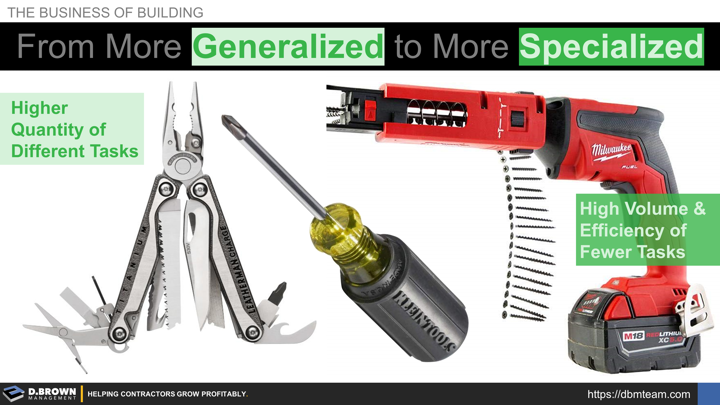Whether you are selecting equipment or designing job roles, think about them as simple as the progression from a highly versatile Leatherman tool to a single purpose screwdriver to a cartridge-fed battery-operated screw gun. One is not better than the other, they are all different tools with different costs and efficiencies.
- The Leatherman can do 15-20 things, is very compact, reasonably priced, and doesn't need any external support like batteries or special cartridges of screws. This is a great tool to take hiking. It's $75-125 depending on the quality and versatility.
- The single-purpose #2 Philips-head screwdriver is constructed much better for the single purpose of installing or removing a screw by hand. It's about $10. This tool will last a lifetime of reasonable use and if you need it even a few times per day, it is much more cost effective than the Leatherman.
- The battery-operated, cartridge-fed screw gun is by far the most expensive and only good for a single purpose. It runs about $400 and will likely only last 12 months under continuous use such as framing or drywall installation. It requires support (charging) and specialized screws.
The Leatherman's magic is in its versatility to do a high quantity of different tasks.
The screw-gun's magic is in its efficiency at a single task.
The first decision on what to do comes down to the basic math of prioritization:
- What is the specific task to be done?
- What is the current frequency of that task per day, week, month, year?
- What is the cost per task using the current person + tool/equipment?
Now look into the future 1 year, 2 years, and possibly 3 years:
- What is the estimated frequency of the task?
- What is the cost of the person, tool, or equipment that is more specialized?
- Is this an additional cost, or will there be some savings from not needing the other?
- What is the revised cost per task taking this into account?
This is the foundation that you should be thinking about when specializing a role, tool, or equipment.
If growth were consistent and linear, your progression to more specialization would be as well.
- What happens if your business must contract for any number of reasons?
- How much will the loss of versatility in your people (job roles), tools, or equipment impact you?
This determines your resiliency. For sustainable growth, leadership decisions must always balance efficiency and resiliency.
Now look at this through the lens of your Talent Value Stream (TVS).
- Will breaking a task down into highly specialized components help develop people faster because they get more cycle times within a narrower scope? For example, consolidating document control on projects with a Project Admin role where they can learn the basics of your tools and construction documentation before growing into roles requiring more coordination, problem-solving, and management.
- Will consolidating tasks and decisions hinder talent development because some roles never get the experience required to effectively train others or make critical decisions required for the next role? An example would be hindering succession readiness because critical decisions are consolidated at a higher-level such as opportunity go/no-go. This can drive incredible efficiency and business outcomes but will hinder growth while increasing risk as it creates a hollow organization.
Every stage of growth at the company and project level requires looking at the degree of specialization that is optimum both today and over the next few years. This is one of those critical leadership decision points about strategy, systems, and structure.

